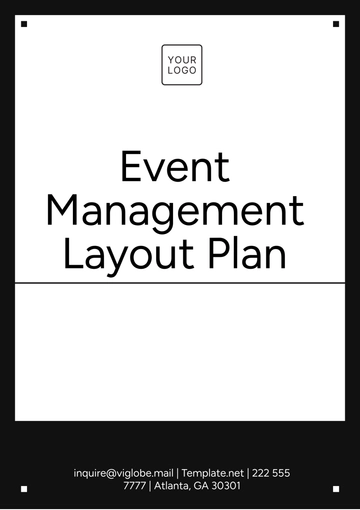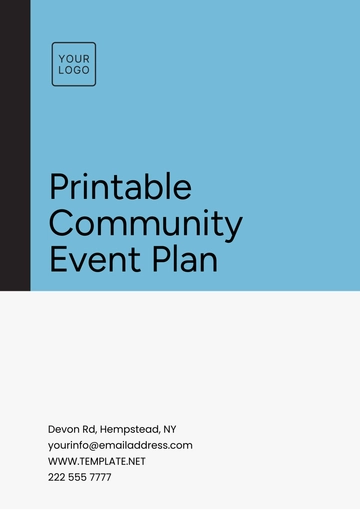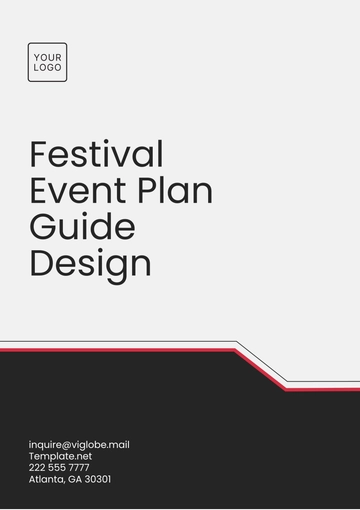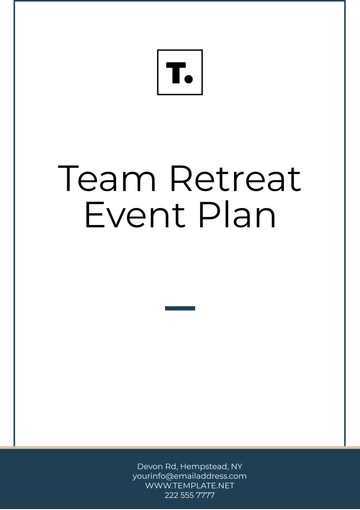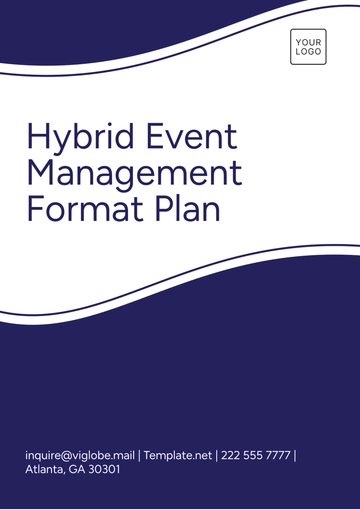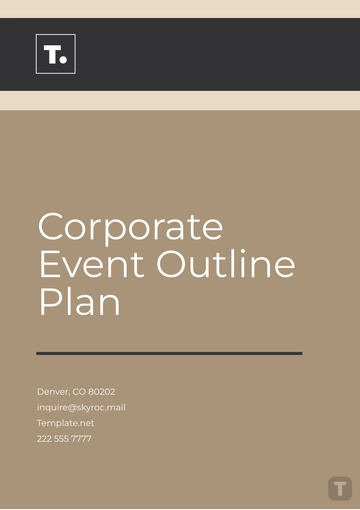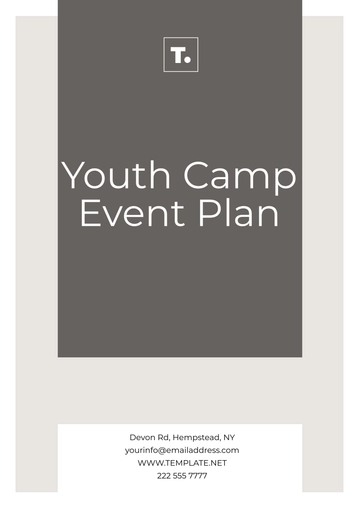Free Photography Event Plan

Introduction
Planning a successful photography event requires meticulous attention to various elements, from logistics to marketing. This comprehensive plan outlines essential steps to ensure a seamless and engaging experience for both photographers and attendees.
I. Event Overview
The event overview provides a foundation for understanding the purpose, theme, and basic details of the photography event.
1.1 Purpose and Theme
Define Objectives:
Clearly articulate the major goals of the event, such as networking opportunities for photographers, showcasing new techniques, or fostering community engagement.Choose a Compelling Theme:
Choose a theme that connects with the audience, whether it's a particular genre like portrait or landscape, or a wider concept like "Capturing Life's Moments," making sure it is visually engaging and capable of inspiring participants.
1.2 Date and Location
Select an Appropriate Date:
Consider scheduling the event on a date that avoids major holidays and local events that could detract from attendance. Research weather conditions if the event involves outdoor photography.Confirm and Book Venue:
Choose a venue that aligns with the theme and can accommodate the expected number of attendees. Ensure it has the necessary facilities, such as lighting, electricity, and breakout areas.
II. Event Logistics
Meticulous planning of logistics is essential to ensure smooth operations before, during, and after the event.
2.1 Budgeting
Estimate Costs:
Outline potential expenses, including venue rental, photography equipment, permits, marketing materials, and staffing. Factor in any unexpected costs.Create a Detailed Budget:
Allocate funds to each category, ensuring there’s a contingency plan for emergencies. Track spending to stay within budget.
2.2 Equipment and Setup
Compile Necessary Equipment:
Create a comprehensive list of photography gear needed for the event, including cameras, lenses, lighting, backdrops, and props.Plan Setup and Dismantling:
Designate a timeline for setting up and dismantling equipment, ensuring team members know their responsibilities. Conduct a site visit before the event for effective planning.
III. Marketing and Promotion
Effective marketing and promotion strategies are crucial to attracting attendees and participants.
3.1 Target Audience
Identify Demographics:
Understand the target audience’s interests, age, experience level, and location to tailor marketing efforts effectively.Create Participant Personas:
Develop detailed personas representing various attendee segments to guide marketing strategies, messaging, and content.
3.2 Promotion Channels
Utilize Social Media Platforms:
Leverage platforms such as Instagram, Facebook, and Twitter to promote the event. Create visually engaging content that highlights the theme and activities.Consider Partnerships:
Collaborate with local businesses, photography clubs, and influencers to broaden reach. Offer cross-promotional opportunities or sponsor packages.
3.3 Event Registration
Set Up an Online Registration Platform:
Utilize intuitive platforms such as Eventbrite or Google Forms to streamline the registration process, and offer early-bird rates or group discounts to encourage more sign-ups.Provide Registration Details:
Share registration information through newsletters, social media, and community bulletin boards to maximize visibility.
IV. Event Day Execution
Ensuring everything runs smoothly on the event day is critical to its success.
4.1 Schedule and Program
Time | Activity |
|---|---|
09:00 AM | Registration and Welcome |
10:00 AM | Keynote Speech |
11:00 AM | Workshops and Breakout Sessions |
Establish a Detailed Agenda:
Create a detailed timeline for the day, including all activities, breaks, and transitions. Share this with all team members in advance.
4.2 Roles and Responsibilities
Assign Roles:
Clearly define responsibilities for team members, covering areas such as registration, equipment management, and workshop facilitation.Create a Contact List:
Compile a list of contact information for all team members and key stakeholders to facilitate quick communication during the event.
V. Post-Event Activities
Post-event activities help ensure continued engagement and gather feedback for future improvements.
5.1 Debrief and Feedback
Conduct a Debrief Session:
Organize a meeting with the team to discuss the event’s successes and areas for improvement. Encourage open feedback and brainstorming for future events.Distribute Feedback Forms:
Use surveys or forms to gather insights from attendees about their experiences and suggestions for improvement.
5.2 Follow-Up Communications
Send Thank You Notes:
Express gratitude to participants, sponsors, and volunteers. Personalize messages where possible to foster relationships.Share Event Highlights:
Post-event highlights, photos, and testimonials on social media and your website to maintain engagement and promote future events.
- 100% Customizable, free editor
- Access 1 Million+ Templates, photo’s & graphics
- Download or share as a template
- Click and replace photos, graphics, text, backgrounds
- Resize, crop, AI write & more
- Access advanced editor
Capture every detail of your photography events with our Photography Event Plan Template from Template.net. This editable and customizable template allows you to tailor your plans effortlessly. Easily modify layouts, colors, and content to suit your unique style. Plus, it's editable in our AI Editor Tool, making it simple to create stunning event outlines in no time!
You may also like
- Finance Plan
- Construction Plan
- Sales Plan
- Development Plan
- Career Plan
- Budget Plan
- HR Plan
- Education Plan
- Transition Plan
- Work Plan
- Training Plan
- Communication Plan
- Operation Plan
- Health And Safety Plan
- Strategy Plan
- Professional Development Plan
- Advertising Plan
- Risk Management Plan
- Restaurant Plan
- School Plan
- Nursing Home Patient Care Plan
- Nursing Care Plan
- Plan Event
- Startup Plan
- Social Media Plan
- Staffing Plan
- Annual Plan
- Content Plan
- Payment Plan
- Implementation Plan
- Hotel Plan
- Workout Plan
- Accounting Plan
- Campaign Plan
- Essay Plan
- 30 60 90 Day Plan
- Research Plan
- Recruitment Plan
- 90 Day Plan
- Quarterly Plan
- Emergency Plan
- 5 Year Plan
- Gym Plan
- Personal Plan
- IT and Software Plan
- Treatment Plan
- Real Estate Plan
- Law Firm Plan
- Healthcare Plan
- Improvement Plan
- Media Plan
- 5 Year Business Plan
- Learning Plan
- Marketing Campaign Plan
- Travel Agency Plan
- Cleaning Services Plan
- Interior Design Plan
- Performance Plan
- PR Plan
- Birth Plan
- Life Plan
- SEO Plan
- Disaster Recovery Plan
- Continuity Plan
- Launch Plan
- Legal Plan
- Behavior Plan
- Performance Improvement Plan
- Salon Plan
- Security Plan
- Security Management Plan
- Employee Development Plan
- Quality Plan
- Service Improvement Plan
- Growth Plan
- Incident Response Plan
- Basketball Plan
- Emergency Action Plan
- Product Launch Plan
- Spa Plan
- Employee Training Plan
- Data Analysis Plan
- Employee Action Plan
- Territory Plan
- Audit Plan
- Classroom Plan
- Activity Plan
- Parenting Plan
- Care Plan
- Project Execution Plan
- Exercise Plan
- Internship Plan
- Software Development Plan
- Continuous Improvement Plan
- Leave Plan
- 90 Day Sales Plan
- Advertising Agency Plan
- Employee Transition Plan
- Smart Action Plan
- Workplace Safety Plan
- Behavior Change Plan
- Contingency Plan
- Continuity of Operations Plan
- Health Plan
- Quality Control Plan
- Self Plan
- Sports Development Plan
- Change Management Plan
- Ecommerce Plan
- Personal Financial Plan
- Process Improvement Plan
- 30-60-90 Day Sales Plan
- Crisis Management Plan
- Engagement Plan
- Execution Plan
- Pandemic Plan
- Quality Assurance Plan
- Service Continuity Plan
- Agile Project Plan
- Fundraising Plan
- Job Transition Plan
- Asset Maintenance Plan
- Maintenance Plan
- Software Test Plan
- Staff Training and Development Plan
- 3 Year Plan
- Brand Activation Plan
- Release Plan
- Resource Plan
- Risk Mitigation Plan
- Teacher Plan
- 30 60 90 Day Plan for New Manager
- Food Safety Plan
- Food Truck Plan
- Hiring Plan
- Quality Management Plan
- Wellness Plan
- Behavior Intervention Plan
- Bonus Plan
- Investment Plan
- Maternity Leave Plan
- Pandemic Response Plan
- Succession Planning
- Coaching Plan
- Configuration Management Plan
- Remote Work Plan
- Self Care Plan
- Teaching Plan
- 100-Day Plan
- HACCP Plan
- Student Plan
- Sustainability Plan
- 30 60 90 Day Plan for Interview
- Access Plan
- Site Specific Safety Plan




